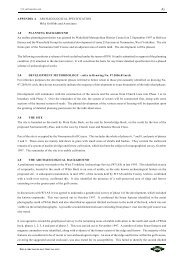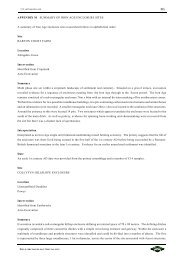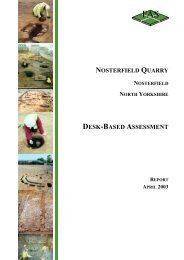ARCHAEOLOGICAL EVALUATION - Mike Griffiths and Associates
ARCHAEOLOGICAL EVALUATION - Mike Griffiths and Associates
ARCHAEOLOGICAL EVALUATION - Mike Griffiths and Associates
Create successful ePaper yourself
Turn your PDF publications into a flip-book with our unique Google optimized e-Paper software.
FAS_lbf01.wpd 169<br />
indicative of domestic activity, although other undated features may also belong to this period.<br />
These pits are likely to form part of a much wider area of activity identified during watching briefs in the<br />
adjacent Nosterfield Quarry (FAS 2005), although the density of features appears to be lower, <strong>and</strong> their state<br />
of preservation poorer at Ladybridge Farm. Within the quarry site, similar features, containing comparable<br />
ceramic (including Grimston <strong>and</strong> Grooved wares) <strong>and</strong> lithic material, were identified in loose groups around<br />
the edges of an in-filled lake, which is likely to have been marshy, <strong>and</strong> seasonally characterised by st<strong>and</strong>ing<br />
water (Figure 109). Some features, which produced evidence for heating <strong>and</strong> quantities of charcoal, have been<br />
tentatively identified as associated hearths. This activity seems to be concentrated in the southern part of<br />
Nosterfield Quarry, possibly delineated by an alignment of pits <strong>and</strong> a ditch. The late Neolithic activity at<br />
Ladybridge Farm also appears to be situated to the south of this potential boundary.<br />
While the distributions evidenced by fieldwalking, test pitting <strong>and</strong> trial tenches adhere to the same general<br />
trends, the investigations revealed that the evidence from surface collection, <strong>and</strong> the presence of finds within<br />
the ploughsoil, cannot be used directly to infer the presence of underlying archaeological features. This lack<br />
of direct correlation has implications for the future interpretation of lithic scatters in this area, <strong>and</strong> also for the<br />
fieldwork strategies that may be subsequently employed as small scale investigations over ‘hot spots’ will not<br />
necessarily identify associated features.<br />
Although no Roman, early medieval or medieval features were identified, vestiges of later agricultural practices<br />
were encountered during the excavation of trial trenches at Ladybridge Farm, where three features were<br />
identified as historic field boundaries. A larger number of such linear features have been investigated at<br />
Nosterfield Quarry; hedgerows <strong>and</strong> ditches were used to delineate the enclosure of the l<strong>and</strong>scape during the<br />
post-medieval period which have since fallen out of use.<br />
10.0 ASSESSMENT<br />
There is a notable absence of archaeology from the early Bronze Age (discounting lithic material of this date<br />
within the ploughsoil) to the early post-medieval period. The later post-medieval period is represented only by<br />
the historic field divisions <strong>and</strong> the manuring material within the ploughsoil. Some of the historic field divisions<br />
were apparently encountered during evaluation, but were unremarkable features.<br />
The programme of evaluation has defined an area of late Neolithic activity. This is manifest as a concentration<br />
of lithic material distributed horizontally <strong>and</strong> throughout the depth of the ploughsoil. It is also present in the<br />
form of scattered small pit features which are identifiable through their content: principally late Neolithic<br />
pottery, <strong>and</strong> were also found to contain broadly dated lithic pieces, charcoal <strong>and</strong> calcined bone. Both the lithic<br />
concentration <strong>and</strong> the excavated features are distributed throughout the southwestern part of the area of<br />
investigation fading to the north <strong>and</strong> the east. The identified area seems to be located on the highest ground<br />
within the investigation area. The broader distribution of these features reflects the trends identified at<br />
Nosterfield Quarry in so far as the activity seems to focus on the zone surrounding the infilled prehistoric lake.<br />
Investigation within Zone E, including surface reconnaissance <strong>and</strong> auger survey, has identified the possible<br />
eastern limit of the infilled lake represented by a marked slope which may reflect the original edge of the lake,<br />
FIELD ARCHAEOLOGY SPECIALISTS







